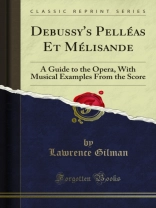Whilst the greatest effort has been made to ensure the quality of this text, due to the historical nature of this content, in some rare cases there may be minor issues with legibility. With the production at Paris in the spring of 1902 of Claude Debussy’s Pelleas et Melisande, based on the play of Maeterlinck, the history of music turned a new and surprising page. It is necessary, declared an acute French critic, M. Jean Marnold, writing shortly after the event, to go back perhaps to Tristan to find in the opera house an event so important in certain respects for the evolution of musical art. The assertion strikes one to-day, five years after, as, if anything, overcautious. Pelleas et Melisande exhibited not simply a new manner of writing opera, but a new kind of music – a new way of evolving and combining tones, a new order of harmonic, melodic and rhythmic structure. The style of it was absolutely new and absolutely distinctive: the thing had never been done before, save, in a lesser degree, by Debussy himself in his then little known earlier work.
Lawrence Gilman
Debussy’s Pelleas Et Melisande [PDF ebook]
A Guide to the Opera, With Musical Examples From the Score
Debussy’s Pelleas Et Melisande [PDF ebook]
A Guide to the Opera, With Musical Examples From the Score
Koop dit e-boek en ontvang er nog 1 GRATIS!
Taal Engels ● Formaat PDF ● ISBN 9780259637905 ● Uitgeverij Forgotten Books ● Gepubliceerd 2019 ● Downloadbare 3 keer ● Valuta EUR ● ID 5560077 ● Kopieerbeveiliging Adobe DRM
Vereist een DRM-compatibele e-boeklezer












